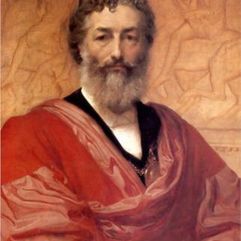

Frederic Leighton
1830 - 1896
Frederic Leighton, 1st Baron Leighton, PRA, known as Sir Frederic Leighton between 1878 and 1896, was a British Victorian painter, draughtsman, and sculptor. His works depicted historical, biblical, and classical subject matter in an academic style. His paintings were enormously popular and expensive, during his lifetime, but fell out of critical favour for many decades in the early 20th century.
Leighton was the bearer of the shortest-lived peerage in history; after only one day, his hereditary peerage became extinct upon his death.
Biography
Leighton was born in Scarborough to Augusta Susan and Dr. Frederic Septimus Leighton (1799-1892), a medical doctor. Leighton's grandfather, Sir James Boniface Leighton (1769-1843), had been the primary physician to two Russian tsars-Alexander I and Nicholas I-and their families, and amassed a fortune while in their service. Leighton's career was always cushioned by this family wealth, with his father paying him an allowance throughout his life. He had two sisters; one of them, Alexandra, was Robert Browning's biographer. He was educated at University College School, London. He then received his artistic training on the European continent, first from Eduard von Steinle and then from Giovanni Costa. At age 17, in the summer of 1847, he met the philosopher Arthur Schopenhauer in Frankfurt and drew his portrait, in graphite and gouache on paper-the only known full-length study of Schopenhauer done from life. When he was 24 he was in Florence; he studied at the Accademia di Belle Arti, and painted the procession of the Cimabue Madonna through the Borgo Allegri. From 1855 to 1859 he lived in Paris, where he met Ingres, Delacroix, Corot, and Millet.
Travel was an important part of Leighton's life from childhood. By his late teens, he was living with his family in Frankfurt, Germany and had already visited many of Europe's major cities, including Florence and Rome, places which he would return to on a great many occasions over the next decades. By his late twenties, extended periods had been spent living in Rome and then Paris and Leighton had made his first trip outside Europe, travelling to north Africa in 1857. Once settled in London, he continued to make extensive trips every year until shortly before his death. The countries that Leighton visited on at least one occasion include Austria, Algeria, Egypt, France, Germany, Greece, Ireland, Italy, Lebanon, Morocco, The Netherlands, Scotland, Spain, Switzerland, Syria, and Turkey.
In 1860, he moved to London, where he associated with the Pre-Raphaelites. He designed Elizabeth Barrett Browning's tomb for Robert Browning in the English Cemetery, Florence in 1861. In 1864 he became an associate of the Royal Academy and in 1878 he became its President (1878-96). His 1877 sculpture, Athlete Wrestling with a Python, was considered at its time to inaugurate a renaissance in contemporary British sculpture, referred to as the New Sculpture. American art critic Earl Shinn claimed at the time that "Except Leighton, there is scarce any one capable of putting up a correct frescoed figure in the archway of the Kensington Museum." His paintings represented Britain at the great 1900 Paris Exhibition.
He was the first President of the Committee commissioning the Survey of London which documented the capital's principal buildings and public art.
Leighton remained a bachelor; rumours of him having an illegitimate child with one of his models, in addition to the supposition that Leighton may have been homosexual, continue to be debated. He certainly enjoyed an intense and romantically tinged relationship with the poet Henry William Greville whom he met in Florence in 1856. The older man showered Leighton in letters, but the romantic affection seems not to have been reciprocated. Enquiry is further hindered by Leighton leaving no diaries, and his letters lack reference to his personal circumstances. No definite primary evidence has yet come to light that effectively dispels the secrecy that Leighton built up around himself, although it is clear that he did court a circle of younger men around his artistic studio.
Leighton was knighted at Windsor Castle in 1878, and was created a baronet eight years later. He was the first painter to be given a peerage, in the 1896 New Year Honours. The patent creating him Baron Leighton of Stretton, in the County of Shropshire, was issued on 24 January 1896; Leighton died the next day of angina pectoris. On his death his hereditary peerage was extinguished after existing for only a day; this is a record in the peerage.
His house in Holland Park, London has been turned into a museum, the Leighton House Museum. It contains many of his drawings and paintings, as well as some of his former art collection, including works by Old Masters and his contemporaries, such as a painting dedicated to Leighton by Sir John Everett Millais. The house also houses many of Leighton's inspirations, including his collection of Iznik tiles. Its centrepiece is the magnificent Arab Hall, which is featured in issue ten of Cornucopia.
A blue plaque commemorates Leighton at Leighton House Museum.
Text courtesy of Wikipedia, 2025


































